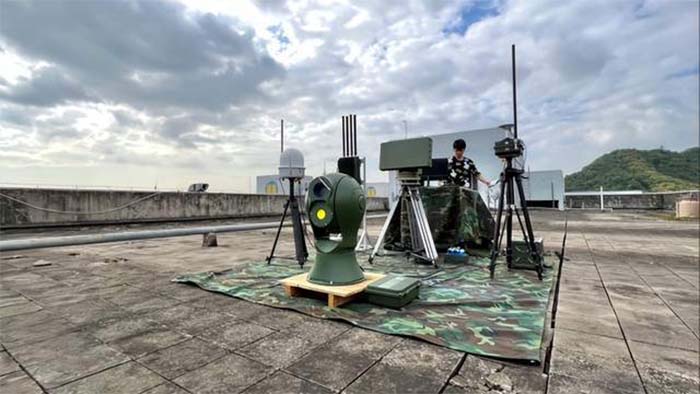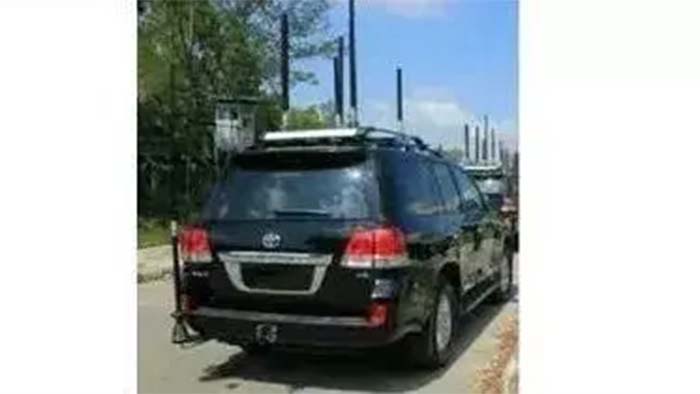What is the anti-jamming technology?
Anti-jamming technology is a technology used to reduce or eliminate unwanted interference in electronic equipment or systems to ensure their normal operation.
Anti-jamming technology focuses on issues such as the source of interference, how interference propagates, and measures to avoid being interfered with (countermeasures). Interference, also known as noise, is a factor other than useful signals that may affect the normal operation of computer equipment or electronic systems.
These interferences may include electromagnetic interference, power supply interference, electrostatic interference, etc. Interference affects the performance of the control system, reduces its reliability, and may even lead to system failure.
Anti-interference technology takes a variety of measures to suppress or eliminate these interferences, for example, shielding technology can be used through the use of metal materials made of containers to isolate circuits from electric or magnetic field interference; can also be used through a reasonable layout of circuit boards, the use of isolation transformers and other measures to reduce electromagnetic interference; can also be optimized by the power supply design and the use of low-pass filters to reduce the power supply noise interference.
In addition, anti-interference technology is widely used in many fields such as radar, military communications, industrial control systems, etc., aiming to improve the reliability and stability of the system.
It is understood that because of the small size of the drone, it can fly at a low altitude, rather than the current civil aviation radar can not low degree of drones.
In order not to let it to the civil aviation aircraft, the major airports use the drone countermeasures system, the use of physical principles, the drone down, but will not cause harm, so that the black flight situation is reduced.
Individuals, companies, detention centers, and other areas to improve confidentiality, and security is improved, so that the black flight of drones forced to land. That’s why it’s on the market and attracts customers’ attention.
What is the drone anti-jamming technology?

Drone anti-jamming technology refers to systematized technology used for drone interception. Because drones can pose a serious threat to civilian and military installations, governments have become increasingly concerned in recent years about the potential security threats posed by drones.
What are the principles of drone anti-jamming technology?
The principle of drone anti-jamming technology refers to the ability and method of using various means to interfere with, disrupt, or destroy drones to protect the security of critical facilities and areas. Drone anti-jamming technologies mainly include three aspects: electronic jamming, physical jamming, and weapon attack.
The electronic interference of UAV anti-jamming technology refers to the interference of UAVs through electronic warfare means to make them lose control or navigation, thus destroying their flight capability.
The electronic interference means of UAV anti-jamming technology include electromagnetic interference, photoelectric interference, radar interference, and so on.
Physical interference of UAV anti-jamming technology refers to the interference of UAVs through physical means, such as the use of laser means to irradiate the UAV fuselage, to cause it to be damaged or lose its attitude control ability.
Weapon attack of drone anti-jamming technology mainly refers to the use of various weapons to attack drones, including the firing of missiles, machine guns, rockets, and so on.
Among them, missile attack is the most common one, which can precisely strike the UAV through the positioning and guidance ability of the missile.
The development of drone anti-jamming technology will play an important role in protecting national security, public interests, and maintaining social order. In the future, with the continuous development and use of drone technology, drone anti-jamming technology will also become more mature and perfect.
The category of drone anti-jamming technology
At present, the drone anti-jamming technology of various countries is mainly divided into three categories.
1). Interference blocking category of drone anti-jamming technology, which is mainly realized by signal interference, acoustic interference, and other technologies.
2). Direct destruction category of drone anti-jamming technology, including using laser weapons, countermeasure UAVs with drones, and so on.
3). Monitoring and control category of drone anti-jamming technology, mainly realized through hijacking radio control and other ways.
At present, all civilian drones need to use radio technology to realize functions such as positioning, remote control, and image transmission.
Special-purpose UAVs can use methods such as terrain matching, image recognition, and high-precision inertial navigation to determine their position and autonomously complete their tasks. Still, they have not yet been popularized in the civil field.
Application fields of drone anti-jamming technology

Drone anti-jamming technology has a wide range of applications in many fields. In the military field, drone interception technology can be used to defend against enemy drone reconnaissance and attacks and protect our military facilities and personnel.
In the field of public security, the technology can be used to prevent terrorists from using drones to carry out malicious attacks and maintain social order.
In the civil aviation field, drone anti-jamming technology can prevent drones from intruding into no-fly zones and ensure flight safety.
In addition, drone anti-jamming technology can be applied to protect sensitive areas such as important infrastructure and government offices.
Which require space secrecy and drone control of the geographical area of the UAV countermeasure system.
What is included in a drone anti-jamming system?
A drone anti-jamming system includes a fixed UAV anti-jamming device.
The UAV anti-jamming system consists of four main sub-systems and modules: anti-jamming search system, optoelectronic tracking system, radio frequency jamming system, and display and control unit.
Among them, the anti-jamming search system accomplishes the function of monitoring and position indication of low-altitude targets in the mission area, which is composed of search radar and radio spectrum monitoring system, and the two search systems can be used independently or in conjunction with each other according to the environment to improve the detection performance; The optical tracking system accomplishes the automatic detection of targets.
The optical tracking system accomplishes the automatic tracking function of the target, which enables the directional antenna of the RF jamming system to align with the target in real-time.
The RF jamming system is used to fulfill the directional RF jamming function on the GPS and wireless telemetry link of the target UAV, which makes the UAV lose control and can’t continue to fly; the display and control unit is mainly used to fulfill the status of the system.
The display and control unit mainly accomplishes the system’s state monitoring, control, posture display, and human-computer interaction functions.
The radio spectrum monitoring system provides long-range detection of the UAV (effective discovery distance ≥3km), and the search radar provides long-range detection of the UAV (effective discovery distance ≥1.5km).
After the data fusion of the two detection data according to the use environment, the photoelectric tracking system is guided to realize the visualized tracking of the UAV.
Finally, the RF jamming system shields the flight control channel and navigation signals of the manned aircraft to drive away/forcibly land the UAV.
1) Search system
A. Radio spectrum monitoring system (frequency scanning)
The radio spectrum monitoring system passively intercepts the graphic signals and remote control signals between the UAV and the remote control, realizing passive detection, lateralization, identification, and localization of the UAV.
B. Search Radar
The radar adopts a C-band, phased array + transceiver all-digital DBF technology system, which has the advantages of high data rate, lightweight, small volume, low power consumption, etc. The radar adopts an all-digital active phased array + transceiver all-digital DBF technology system.
The radar adopts an all-digital active phased array technology system, through modularization, refinement design, comprehensive use of adaptive moving target detection, digital T/R (transmit/receive), DBF (digital beam forming), analog-digital integration design, and other technical means.
With good low-altitude detection performance, strong mobile tracking capability, high measurement accuracy, and low cost, it is a phased array radar with excellent performance in detecting unmanned aircraft, which can realize the detection, alert, and target indication of unmanned aircraft in key monitoring areas, and provide the monitoring system with real-time, accurate, and continuous air condition and target information.
2) Photoelectric tracking system
The optoelectronic tracking system consists of a tracking turntable and an optoelectronic module, which is equipped with an uncooled infrared focal plane detector, a high-definition visible light camera, and an image processing board.
The photoelectric tracking system completes the initial alignment of the target according to the target position information provided by the search system and then searches for the target near the initial alignment area.
During the search process, the suspicious target can be confirmed by automatic identification or manual designation, and then transferred to the target automatic tracking mode, so that the optoelectronic sensor’s visual axis and the RF interference antenna mounted on the tracking turntable can be aligned with the target in real-time.
3) Radio Frequency Jamming System
The UAV precise directional RF jamming system adopts photoelectric identification and automatic tracking technology, precision servo control technology, and high gain directional RF jamming technology to realize the UAV search system.
Including passive detection and positioning equipment, active radar and optoelectronic search equipment, etc., the detection of the suspicious target of the secondary search, precise positioning, and automatic tracking function.
Launching a directional radio frequency interference signal, paralyzes the drone’s satellite navigation, wireless remote control, and wireless map transmission link, making the drone lose the ability to continue to fly according to the predetermined flight path, to achieve the purpose of forced landing or drive away from the drone.
The necessity of drone anti-jamming technology system

In recent years, with the increasing application of drones in aerial photography, express delivery, surveying, searching, plant protection, etc., people’s quality of life and social efficiency have been rapidly improved. While the drone market is developing rapidly, more and more black flights of drones have brought serious threats and troubles to national security and social stability.
Prisons are key households patronized and threatened by illegal drones.
In response to incidents of intrusion by drones, surreptitious filming, and even air-dropping of contraband in supervised places, some provinces and regions in China have initiated pilots in key prisons to set up a drone defense system to detect, monitor interfere with, and drive away drones trespassing in restricted areas.
8. What are the frequency bands for drones and the anti-jamming technology?
To perform effective anti-jamming of UAVs on different frequencies, UAV omni-directional suppressive devices can usually emit suppressive jamming signals in multiple frequency bands.
Currently, the frequency bands commonly used for drones and drone anti-jamming systems are GPS, GNSS, 2.4 GHz, 5 GHz, 433 MHz, 868 MHz, and 915 MHz, with the possibility of adding 315 MHz, 750 MHz, 800 MHz, 950 MHz, 1.2 GHz, 1.4 GHz, 1.7 GHz, 1.8 GHz, 1.9 GHz, 2.1 GHz, 2.3 GHz, 2.6 GHz, 3.5 GHz, and so on.
Omni-directional drone anti-jamming technology system devices usually also include part of the frequency band for wireless communications equipment (such as walkie-talkies and cordless telephones) as well as the frequency band for common remotely controlled hazards, so this type of equipment is usually characterized by its versatility and so on.
This type of equipment usually has a higher transmit power and a wider coverage area, so it is usually suitable for strong anti-jamming drone interception on special occasions, such as militarized sites, nuclear power plants, and prisoner vehicle escort.
How does drone anti-jamming work?
Drone anti-jamming technology systems are tracked and located by long-range detection technology. Effective detection, identification, tracking, and localization are prerequisites for successful countermeasures against drones.
The flight characteristics of a drone, the infrared properties of its body, the sounds it makes, the shadows it casts in the sun, and the radio signals it emits can all be features that can be utilized by detection systems.
Therefore, radar, radio frequency, optoelectronic, infrared, and acoustic means can be used to anti-jamming drones by detecting and sensing drone infestations within certain airspace.
For example, drones can be identified and detected using electronically scanned Doppler radar, and tracked and localized using high-precision infrared and visible light cameras and advanced video capture software.
The most direct way to anti-jamming drones is to destroy them by physically hardening them, causing irreversible and fatal destruction to the drone. Destruction by fire using missiles and traditional munitions such as anti-aircraft guns and anti-aircraft machine guns is a common mode of air defense operations today.
Combined bomb and artillery air defense systems can effectively strike drones at ultra-low altitudes.
For example, using 35 mm rapid-fire guns to fire multiple beams of directional prefabricated fragmentation programming rounds, which, when exploded, can point a large number of prefabricated fragments directly in the direction of the target, generating a high-density fragmentation beam that intercepts and destroys the drone’s target.
Laser weapons can fire high-temperature laser beams to damage or destroy UAV hardware systems at close range. Microwave weapons can emit high-energy electromagnetic pulses to penetrate UAV hardware equipment at high pressure, and with wide spectrum coverage and a large area of destruction, they are an effective means of dealing with UAV swarms.
In 2019, the U.S. Army demonstrated a microwave weapon system called “THOR” at Cortland Air Force Base, which instantly deactivated the drone when it was hit by electromagnetic rays and spiraled down after losing control.
Aiming at the characteristics of UAVs that are highly dependent on control information links, a more economical countermeasure is to adopt electromagnetic suppression to cut off the accusation information, so that the UAV suffers non-destructive failure.
Signal suppression technology is used to block and isolate the uplink radio control signals transmitted to the drone from the ground control station, cutting off its control nervous system. Unable to receive command information, the drone either makes an emergency landing in place, hovers over the last guidance position waiting for a reset of the link, or returns on its navigation to its original route.
Unlike the hard-kill destruction method, soft-wound suppression is commonly used to anti-jamming drone targets flying over densely populated areas, and can effectively avoid casualties on your side due to in-situ crashes.
Electromagnetic jamming of drones, by infiltrating, confusing, and disrupting the feedback signals from drones to ground control stations, the navigation satellite signals of their positioning, and airborne reconnaissance and sensing equipment, etc., causes the drones to fall into a daze due to the loss of position data, and they are forced to land or return to their flights due to the loss of their ability to continue to carry out their missions.
Through pseudo-satellite jamming equipment, high imitation pseudo-positioning signals are emitted to the drone’s satellite navigation chip and made to be mistaken for the real ones, and the drone will deviate from its route due to distorted judgment of its position.
Photoelectric and acoustic wave jamming equipment blinds the camera equipment used by the drone to sense the external environment and disrupts the gyroscope sensor used for flight attitude control, causing it to fly randomly and crash.
Disguising drone control signals, seizing control, and trapping through electronic warfare are the pinnacle of counter-drone technology.
Using electronic warfare equipment, it identifies and analyzes the remote control signals of enemy drones from a large number of radio signals, uses computers with strong computing power to decipher the key parameters of their command codes, and then mimics ground control stations to transmit a large number of fake signals to the drones.
It then invades the system control loop, monitors the flight status information, destroys the internal control software, and modifies its flight parameters so that the drone follows the instructions of the spoofed signals and lands at the designated location.
Drawing on the netting methods used by humans to hunt birds and fowl, the drone is captured harmlessly by catapulting from the ground or throwing capture nets from the air.
This type of net catching method has a low economic cost, little damage to the UAV, and can be used repeatedly, but the disadvantage is that it requires high flight parameters and stability for large UAVs, and the ejection height of the ground catapult is limited.
For example, the SKYWALL drone anti-jamming technology system developed in the United Kingdom can eject a net with a parachute from a fixed position on the ground or from the top of a vehicle to capture low-altitude small drones, with an effective capture distance of 250 meters.
Now and feature of drone anti-jamming technology systems

According to the data, the drone anti-jamming technology system market is expected to grow at a rate of approximately 23.89% per annum from 2017 to 2022.
Among them, the demand for anti-drone systems in the Asia-Pacific region will account for 30% of the global market, and anti-drone products will maintain high growth in the long term.
With the rapid development of UAV technology and products, the anti-jamming drone issue has become more and more prominent and the demand has become more and more intense, and all countries in the world have stepped up the formulation and launch of drone anti-jamming technology system strategies.
This has given a strong impetus to the rapid development of anti-UAV technology and equipment, and the development of anti-UAV systems has presented the characteristics of diversification, specialization, intellectualization, and low cost.
Unlike the traditional method of utilizing missiles and artillery shells to defend against drones, drone anti-jamming technology systems have the advantages of rapidity, flexibility, and high cost-effectiveness, and these advantages have become the major reasons why countries are scrambling to develop anti-drone systems.
At the same time, drone anti-jamming technology systems are playing an increasingly important role in the military, counter-terrorism, security, and civilian fields, which will lead to the rapid development of anti-UAS.
Besides this What is Drone Anti-jamming Technology article, you may also be interested in the below articles.
Internal Antenna VS. External Antenna
LTE Vs. 5G: Is 5G Better Than LTE?




